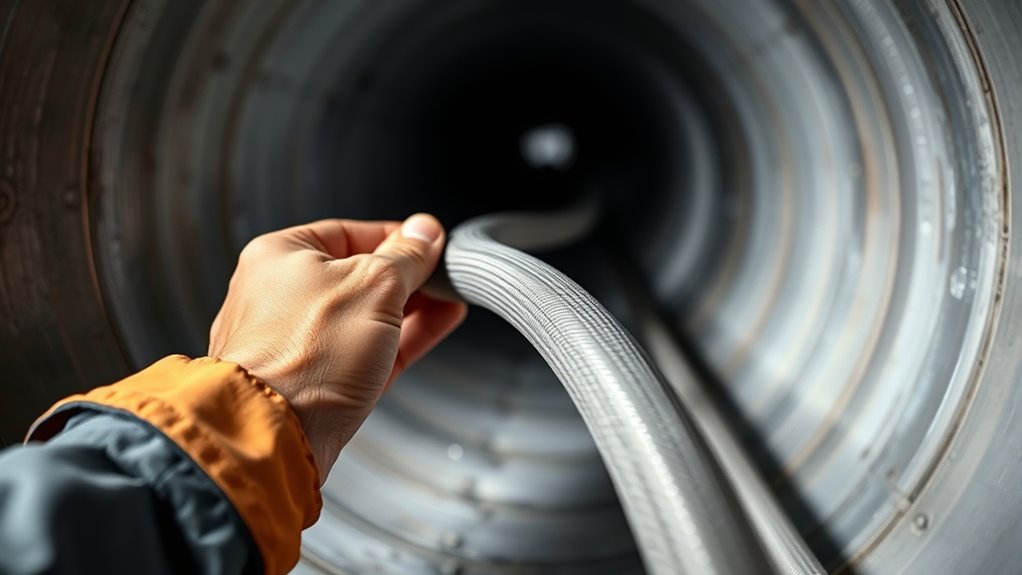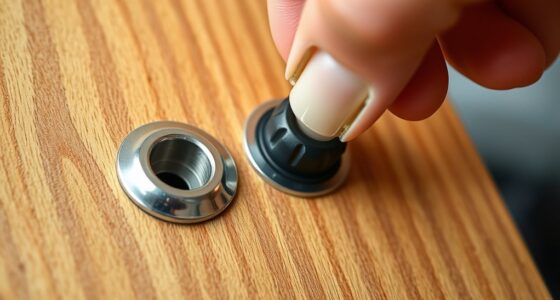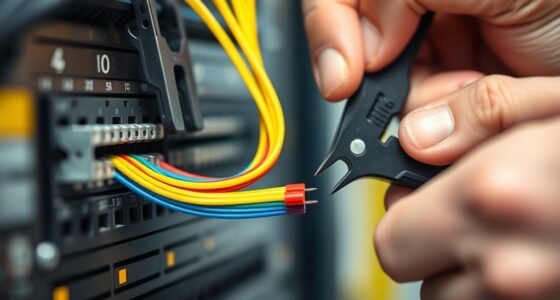While it’s easy to focus on laying cables quickly, neglecting the bend radius can lead to serious issues down the line. Sharp turns or tight curves might seem harmless at first, but they can cause internal damage that compromises performance and longevity. Properly managing bend radius isn’t just a recommendation; it’s a vital step to guarantee your cables stay reliable and safe. Understanding how to control bends during installation can save you time and costly repairs later on.
Key Takeaways
- Always refer to the manufacturer’s minimum bend radius specifications for your cable type.
- Use gentle curves and avoid sharp bends to prevent damaging internal conductors or insulation.
- Employ supporting tools like cable rollers or guides to maintain consistent bend radius during installation.
- Incorporate slack and loops to create gradual curves, reducing stress on the cable.
- Regularly inspect installed cables to ensure bend radius limits are maintained and prevent overstressing.

Properly managing bend radius during cable installation is essential to guarantee the longevity and performance of your cables. When you handle cables with care, you protect their internal conductors and insulation from damage that could compromise signal quality or lead to early failure. One of the most critical factors to consider is cable flexibility, which varies depending on the type of cable you’re working with. Flexible cables are designed to bend more easily without damage, making them suitable for installations requiring tight curves. Rigid cables, on the other hand, demand more careful handling and gentler curves to prevent internal stress. Recognizing the specific cable type and its flexibility helps you determine the appropriate installation techniques to avoid overstressing the cable.
Using the right installation techniques is key to maintaining proper bend radius. Always refer to the manufacturer’s specifications for minimum bend radius, which is typically expressed as a multiple of the cable’s diameter—commonly 10 times the diameter for many cables. Exceeding this limit can cause microfractures in the insulation or damage internal conductors, resulting in degraded performance or failure. To adhere to these guidelines, you should plan your route carefully and avoid sharp bends or kinks. When you need to navigate around obstacles, use gentle curves instead of sharp angles, ensuring that the bend radius remains within the recommended limits. Employing proper tools, such as cable rollers or guides, can help you maintain a consistent bend radius and prevent accidental overstressing.
Incorporate gradual curves into your installation process rather than forcing a cable into a tight bend. If necessary, use slack to create loops or gentle arcs that respect the minimum bend radius. When pulling cables, do so slowly and steadily, avoiding sudden pulls that might cause the cable to bend too sharply. Also, keep in mind that certain environments or long runs may require support systems like cable trays or conduits, which help distribute stress evenly and prevent excessive bending. Regularly inspecting the cable as you install it ensures you catch any unintended sharp bends early. Additionally, understanding the importance of cable flexibility helps you select appropriate cables for your specific application. Remember, the key to preserving cable integrity is understanding its flexibility and applying proper installation techniques, which together extend the lifespan of your system and ensure optimal performance.
Frequently Asked Questions
What Tools Help Measure Bend Radius Accurately?
You should use bend radius tools and measurement devices to accurately gauge cable bend radius. These tools, like flexible rulers, bend radius gauges, or specialized digital measurement devices, help you verify cables aren’t bent too tightly. By consistently checking with these measurement devices, you prevent damage and maintain cable integrity. Always keep a set of bend radius tools handy during installation to make sure you stay within safe limits efficiently.
How Does Temperature Affect Cable Bend Radius?
Think of your cable as a dancer whose flexibility depends on the stage’s temperature. When it’s warm, thermal expansion makes the material more pliable, allowing for tighter bends without damage. Conversely, cold temperatures stiffen the cable, reducing its flexibility and increasing the risk of exceeding the recommended bend radius. To keep your installation graceful and safe, account for temperature changes and choose cables suited for your environment’s thermal conditions.
Can Improper Bend Radius Cause Future Cable Failures?
Yes, improper bend radius can cause future cable failures by stressing the cable’s insulation and conductors. This compromises cable durability and increases the risk of cracks, breaks, or shorts over time. To prevent this, follow installation best practices that specify correct bend radii, ensuring the cable remains within safe limits. Proper handling during installation helps maintain cable integrity and prolongs its lifespan, avoiding costly repairs or replacements later.
Are There Industry Standards for Bend Radius in Different Cables?
Ever wonder if there are industry standards for bend radius in cables? Yes, there are! Industry standards and cable specifications guide you to maintain proper bend radius, preventing damage and ensuring longevity. These standards vary depending on cable types, such as fiber optics or power cables. Always consult the manufacturer’s guidelines and relevant standards to avoid future issues, ensuring your installation remains reliable and safe.
How to Train Staff on Proper Bending Techniques?
To train staff on proper bending techniques, you should start with thorough staff training that emphasizes the importance of maintaining the correct bend radius. Show them visual aids and hands-on demonstrations to illustrate proper bending techniques. Reinforce the training regularly, assess their skills, and provide feedback. Making sure your team understands industry standards helps prevent damage and ensures cable longevity, ultimately improving installation quality and safety.
Conclusion
By carefully managing the bend radius during cable installation, you can considerably extend your cables’ lifespan and maintain ideal performance. Some might think that bending cables tightly saves time, but research shows that sharp curves cause microfractures and insulation damage over time. So, always follow manufacturer guidelines and use gentle curves. Think of it this way: a little extra care now prevents costly repairs later, proving that proper handling truly pays off.









